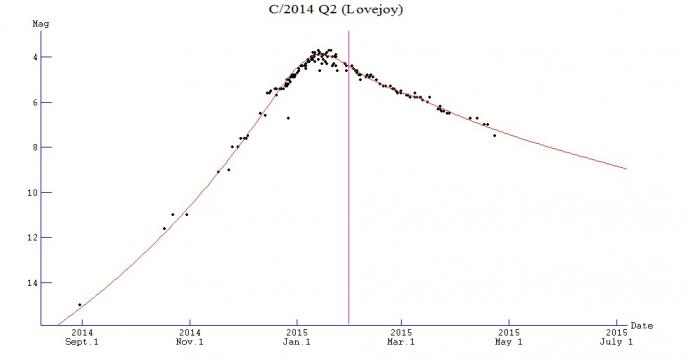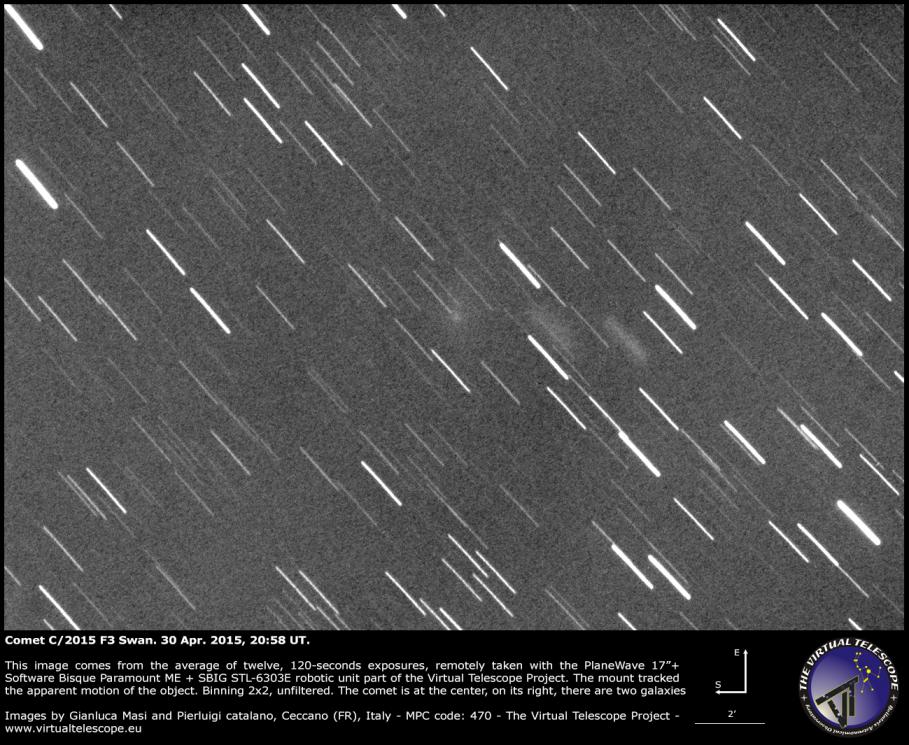ALPO COMET SECTION NEWS FOR MAY 2015
2015-May-01
For the first time in months the brightest comet in the sky will not be C/2014 Q2 (Lovejoy). Sometime this month it should be surpassed by newly discovered C/2015 G2 (MASTER). Unfortunately for us up north, MASTER will only be visible from southern latitudes so Lovejoy will remain the best comet for northerners.
Visual and CCD magnitude measurements of comets C/2015 G2 (MASTER), C/2015 F5 (SWAN-Xingming), C/2015 F3 (SWAN), C/2015 F2 (Polonia), C/2014 Q2 (Lovejoy), C/2014 E2 (Jacques), C/2013 X1 (PANSTARRS), C/2013 US10 (Catalina) and 88P/Howell were submitted by Salvador Aguirre (3), Carl Hergenrother (15), John Sabia (1) and Willian Souza (3). We’ve also received CCD images of comets from Carl Hergenrother, Gianluca Masi, Frank Melillo and John Sabia.
Morning Comets
C/2014 Q2 (Lovejoy) [Perihelion on 2015-Jan-30 at 1.29 AU from the Sun]
Lovejoy has been the brightest comet in the sky for the past ~6 months or so. As May begins, it is still a 7th magnitude object. It may still be as bright as 8th magnitude at the end of the month if its recent rate of fading continues. Its distance from the Sun (1.86 to 2.18 AU) and Earth (2.09 to 2.31 AU) continues to increase this month as its passes through the northern circumpolar sky in Cassiopeia (May 1), Cepheus (May 2-27) and Ursa Minor (May 27-31). On May 29 it passes within 1° of the north celestial pole.
The plot below shows a lightcurve of C/2014 Q2 produced from visual and CCD magnitude measurements submitted to the Section.
Recent ALPO images and observations of C/2014 Q2 (Lovejoy) can be found in the Comet Section Image Gallery and Magnitude Database. Finder charts can be found at the ALPO Comet Finder Chart page.
C/2015 G2 (MASTER) [Perihelion on 2015-May-23 at 0.78 AU from the Sun]
Recently discovered Comet MASTER was found on Apr 7 UT in data taken by the MASTER (Mobile Astronomical System of the Telescope-Robots) program with a 0.4-m f/2.5 telescope located at the South African Astronomical Observatory. At discovery, Comet MASTER was located very close to 9th magnitude comet 88P/Howell. ALPO observers have watched MASTER brighten from magnitude 8.8 on April 16th to 7.7 on the 29th. The comet should peak around magnitude 6.5 around the time of its closest approach to Earth on May 13 at 0.47 AU. The comet will have faded to around magnitude 7 by perihelion on May 23 at 0.78 AU.
MASTER will only be visible from the southern hemisphere or very low northern latitudes this month. It starts the month as a morning object but passes south of the Sun and enters the evening sky around mid-month as it travels through Sculptor (May 1-8), Fornax (8-13), Eridanus (13-15), Caelum (15-16), Lepus (16-21), Canis Major (21-25) and Monoceros (26-31). It will be lost in the glare of the Sun even for southern observers by late July and won’t reappear till September. By then northern observers will also be able to observe it though it may have faded below 11th-12th magnitude by then.
Recent ALPO images and observations of C/2015 G2 (MASTER) can be found in the Comet Section Image Gallery and Magnitude Database. Finder charts can be found at the ALPO Comet Finder Chart page.
88P/Howell [Perihelion on 2015-Apr-06 at 1.36 AU from the Sun]
Comet Howell passed perihelion last month at a distance of 1.36 AU from the Sun. Recent observations place Howell at magnitude 9.5 to 10.0 though it should fade by a magnitude or so during May. The comet can be seen in the morning sky as it moves through Aquarius (May 1-13), Pisces (13-25) and Cetus (25-31).
Recent ALPO images and observations of 88P/Howell can be found in the Comet Section Image Gallery and Magnitude Database. Finder charts can be found at the ALPO Comet Finder Chart page.
New Discoveries
Since the last update 3 new comets have been discovered.
C/2015 F5 (SWAN-Xingming) was discussed in an April 11th Comet Section post. It is a shared discovery between SWAN data miners Szymon Liwo (Swidnica, Poland) and Worachate Boonplod (Samut Songkhram, Thailand) and Xingming sky survey members Guoyou Sun and Xing Gao (XinJiang, China).
Perihelion occurred on March 28 at a small distance of 0.35 AU followed by closest approach to Earth on April 14 at 0.60 AU. The comet is currently fading fast from an observed peak brightness of 10th magnitude.
C/2015 G2 (MASTER) was described above.
C/2015 H1 (Bressi) was found by Terry Bressi with the Spacewatch 1.8-m telescope on Kitt Peak on April 20 UT. At discovery, Bressi was 18th magnitude. Perihelion occurred earlier in the month (Apr. ![]() at a distance of 1.94 AU from the Sun. It should only get as bright as 17th magnitude.
at a distance of 1.94 AU from the Sun. It should only get as bright as 17th magnitude.
Other Comet News
I forgot to mention in last month’s News that March discovery C/2015 F3 (SWAN) shares a similar orbit with C/1988 A1 (Liller) and C/1996 Q1 (Tabur). Liller was a nice comet during the winter and spring of 1988 when it reached 5th magnitude. Tabur also reached 5th magnitude but underwent a disruption event prior to perihelion and slowly disintegrated from sight. Surprisingly the ‘apparently’ fainter C/2015 F3 survived perihelion but recent images, like the one below by Comet Section contributor Gianluca Masi, show the comet slowly fading away. Whether this is due to a disruption of the nucleus or just normal (but rapid) fading due to an increasing heliocentric distance remains to be seen. Comet SWAN is currently located a few degrees from the north celestial pole in Camelopardalis. As the image shows, it is very diffuse and about 12-13th magnitude or fainter.
As always, the Comet Section is happy to receive all comet observations, whether images, drawings or magnitude estimates.
- Carl Hergenrother (Acting ALPO Comet Section Coordinator)





